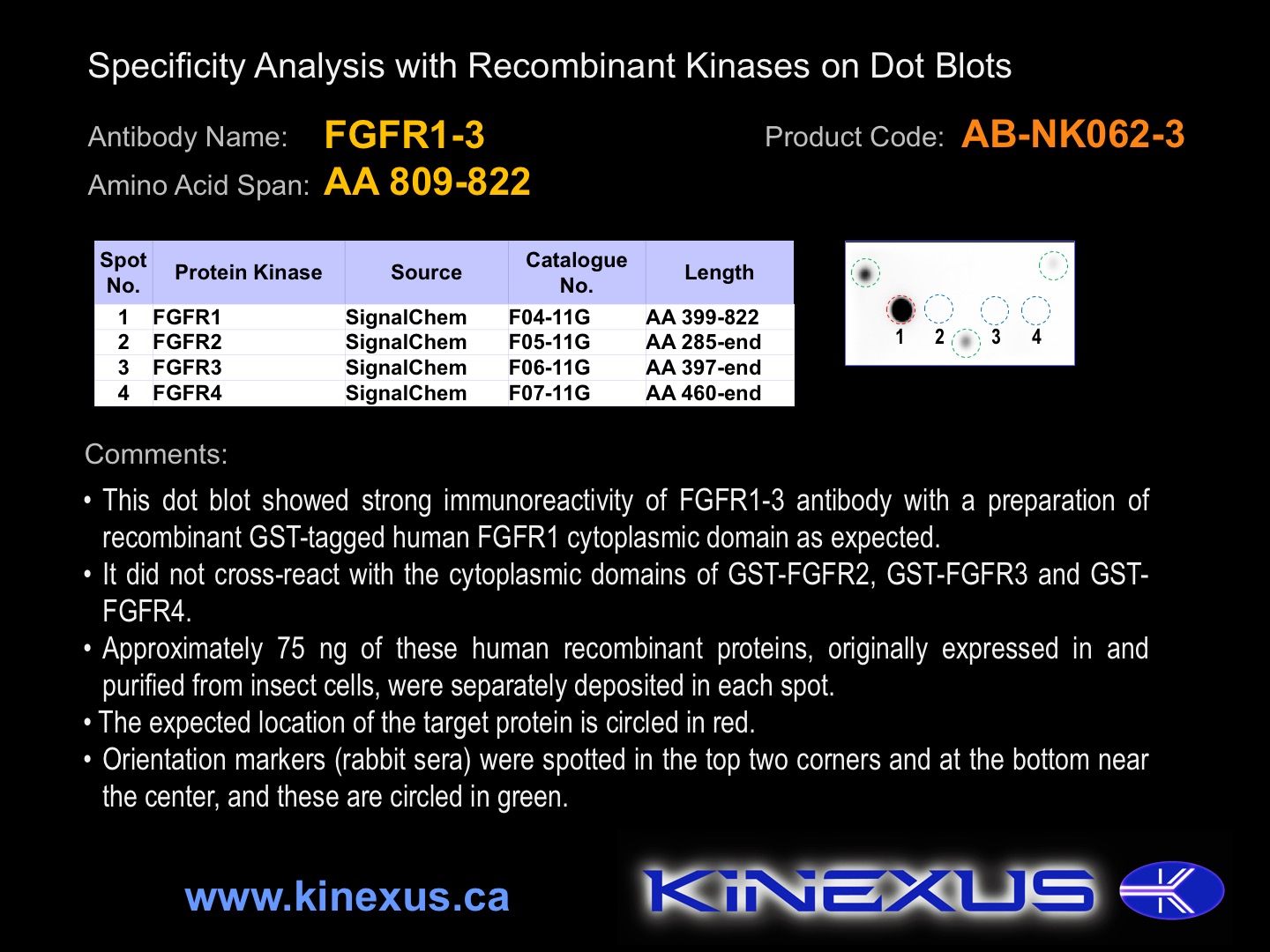Product Name: FGFR1-3
Product Number: AB-NK062-3
| Size: | 25 µg | Price: | 89.00 | |
| $US |
Target Full Name: Fibroblast growth factor receptor-tyrosine kinase 1; Basic fibroblast growth factor receptor 1
Target Alias: BFGFR; BFGF-R; CD331; CEK; C-fgr; FGFBR; FGFR-1; Fgr; FLT2; KAL2; Pfeiffer syndrome; HBGFR; KAL2; N-SAM; OGD; bFGF-R-1; H2; H3; H4; H5; ENSG00000077782
Product Type Specific: Protein kinase pan-specific antibody
Antibody Code: NK062-3
Antibody Target Type: Pan-specific
Protein UniProt: P11362
Protein SigNET: P11362
Antibody Type: Polyclonal
Antibody Host Species: Rabbit
Antibody Immunogen Source: Human FGFR1 sequence peptide Cat. No.: PE-01AUD99
Target Alias: BFGFR; BFGF-R; CD331; CEK; C-fgr; FGFBR; FGFR-1; Fgr; FLT2; KAL2; Pfeiffer syndrome; HBGFR; KAL2; N-SAM; OGD; bFGF-R-1; H2; H3; H4; H5; ENSG00000077782
Product Type Specific: Protein kinase pan-specific antibody
Antibody Code: NK062-3
Antibody Target Type: Pan-specific
Protein UniProt: P11362
Protein SigNET: P11362
Antibody Type: Polyclonal
Antibody Host Species: Rabbit
Antibody Immunogen Source: Human FGFR1 sequence peptide Cat. No.: PE-01AUD99
Antibody Immunogen Sequence: CRHPAQLANGGLKRR
Antibody Immunogen Description: Corresponds to amino acid residues R809 to R822; C-terminus
Production Method: The immunizing peptide was produced by solid phase synthesis on a multipep peptide synthesizer and purified by reverse-phase hplc chromatography. Purity was assessed by analytical hplc and the amino acid sequence confirmed by mass spectrometry analysis. This peptide was coupled to KLH prior to immunization into rabbits. New Zealand White rabbits were subcutaneously injected with KLH-coupled immunizing peptide every 4 weeks for 4 months. The sera from these animals was applied onto an agarose column to which the immunogen peptide was thio-linked. Antibody was eluted from the column with 0.1 M glycine, pH 2.5. Subsequently, the antibody solution was neutralized to pH 7.0 with saturated Tris.
Antibody Immunogen Description: Corresponds to amino acid residues R809 to R822; C-terminus
Production Method: The immunizing peptide was produced by solid phase synthesis on a multipep peptide synthesizer and purified by reverse-phase hplc chromatography. Purity was assessed by analytical hplc and the amino acid sequence confirmed by mass spectrometry analysis. This peptide was coupled to KLH prior to immunization into rabbits. New Zealand White rabbits were subcutaneously injected with KLH-coupled immunizing peptide every 4 weeks for 4 months. The sera from these animals was applied onto an agarose column to which the immunogen peptide was thio-linked. Antibody was eluted from the column with 0.1 M glycine, pH 2.5. Subsequently, the antibody solution was neutralized to pH 7.0 with saturated Tris.
Antibody Modification: Unconjugated. Contact KInexus if you are interest in having the antibody biotinylated or coupled with fluorescent dyes.
Antibody Concentration: 1 mg/ml
Storage Buffer: Phosphate buffered saline pH 7.4, 0.05% Thimerasol
Storage Conditions: For long term storage, keep frozen at -40°C or lower. Stock solution can be kept at +4°C for more than 3 months. Avoid repeated freeze-thaw cycles.
Product Use: Western blotting | Antibody microarray
Antibody Dilution Recommended: 2 µg/ml for immunoblotting
Antibody Potency: Strong immunoreactivity with recombinant human FGFR1 on protein dot blots.
Antibody Species Reactivity: Human
Antibody Concentration: 1 mg/ml
Storage Buffer: Phosphate buffered saline pH 7.4, 0.05% Thimerasol
Storage Conditions: For long term storage, keep frozen at -40°C or lower. Stock solution can be kept at +4°C for more than 3 months. Avoid repeated freeze-thaw cycles.
Product Use: Western blotting | Antibody microarray
Antibody Dilution Recommended: 2 µg/ml for immunoblotting
Antibody Potency: Strong immunoreactivity with recombinant human FGFR1 on protein dot blots.
Antibody Species Reactivity: Human
Antibody Positive Control: The observed molecular mass of the processed target protein on SDS-PAGE gels is reported to be around 100-110 kDa.
Antibody Specificity: High
Antibody Cross Reactivity: No immunoreactivity on protein dot blots with recombinant human FGFR2, FGFR3 and FGFR4.
Related Product 1: FGFR1-3 blocking peptide
Related Product 2: FGFR1-1 pan-specific antibody (Cat. No.: AB-NK062-2)
Related Product 3: FGFR1-pY653+pY654 phosphosite-specific antibody (Cat. No.: AB-PK634)
Antibody Specificity: High
Antibody Cross Reactivity: No immunoreactivity on protein dot blots with recombinant human FGFR2, FGFR3 and FGFR4.
Related Product 1: FGFR1-3 blocking peptide
Related Product 2: FGFR1-1 pan-specific antibody (Cat. No.: AB-NK062-2)
Related Product 3: FGFR1-pY653+pY654 phosphosite-specific antibody (Cat. No.: AB-PK634)
Scientific Background: FGFR1 (Flt2) is a protein-tyrosine kinase of the TK group and FGFR family. It is a fibroblast growth factor receptor, and is alternatively spliced generating multiple variants that are differentially expressed during embryogenesis and in the adult body. It is highly expressed and widely distributed in most tested human tissues. FGF receptors plays an important role in multiple biological processes, including mesoderm induction and patterning, cell growth and migration, organ formation and bone growth. FGFR1 is involved in cell proliferation, differentiation, migration, and embryonic development. FGFR1 is activated by basic-FGF, which induces dimerization and transautophosphorylation. Phosphorylation of Y653 and Y654 increases kinase activity. Phosphorylation of Y766 induces interaction of FGFR1 with PLCg1 and SHB, induces FRS2 phosphorylation, and activation of RAS and MAPK signalling, leading to cell proliferation. Phosphorylation of Y154 induces receptor internalization. It can phosphorylate GAB1, PLCG1, FRS2, and SHB. FGFR1 has been linked with the development of Pfeiffer Syndrome (PS), Kallmann Syndrome Type 2 (KAL2), Stem Cell Leukemia Lymphoma Syndrome (SCLL), breast carcinomas (ductal), lung bronchoalveolar carcinomas and lung large cell carcinomas.
© Kinexus Bioinformatics Corporation 2017


